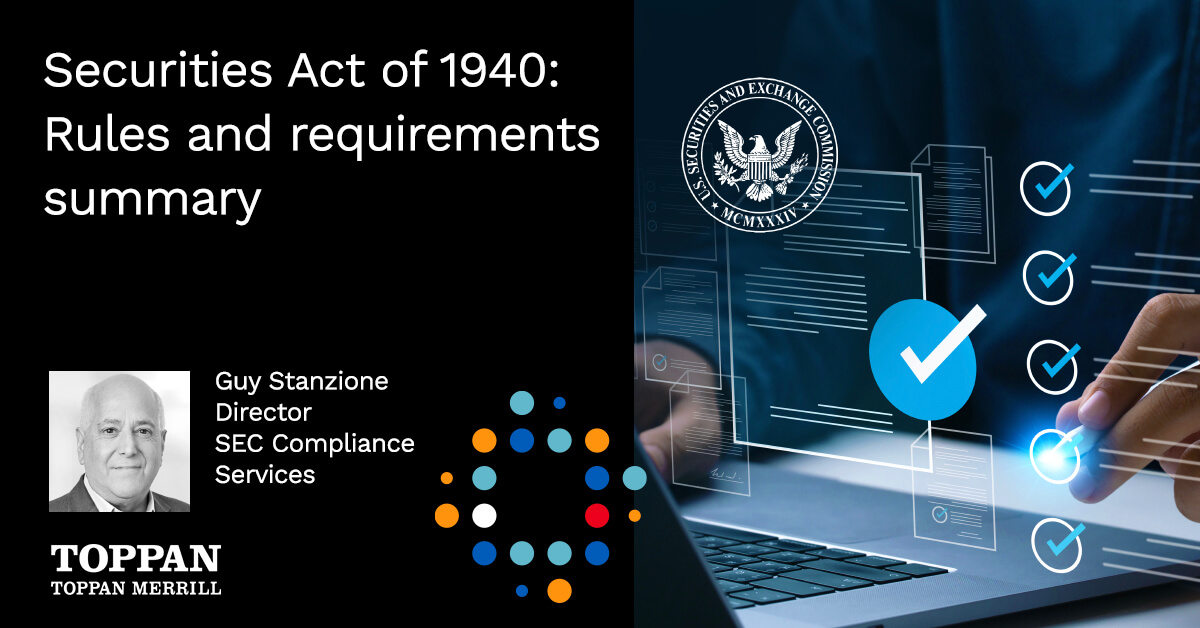Transcript
Scott Snyder: Hello, I’m Scott Snyder, and I’m very pleased to be joined today by Guy Stanzione, Director of Compliance Services at Toppan Merrill. Guy, thank you very much for joining me.
Guy Stanzione: Hi, Scott. Thanks for having me.
Scott: Guy, effective July of next year, 2024, the SEC has mandated that all mutual funds and ETFs filing under Form N-1A produce Tailored Shareholder Reports, or TSRs for short. The SEC’s stated overarching goal is to increase transparency of fund costs and performance. Guy, before we dive into some of the real particular challenges of the TSR rule for mutual funds, can you give us a quick history lesson on the tailored shareholder report rule and what the SEC is really going after?
Guy: Sure, Scott. If you look historically at the traditional annual report, as we call it, they were made up of a lot of tables and a lot of text, the belief was most people didn’t read them. They were distributed, thrown in the trash. They were complicated to read. There was a lot of data and a lot of data that didn’t apply to the person that had that book physically in their hand. With the transition to a tailored shareholder report, or as the SEC called it in the proposal, the summary shareholder report, what the plan was to create a short form document, much like summary prospectus, that’s been around since 2009 to give the investor a short form document, they could read, see the costs, see the performance results, and be able to get through the document pretty quickly. From the proposal to the final rule, what changed, is the SEC went away from the fund level or the series level for the document creation to the share class level, which the intent was to provide that transparency, because now if somebody is invested in a specific class, they’re only getting the document for that specific class and all the other material that doesn’t pertain to them would not even be in their document. But what the introduction of the share class level document did is it added a level of complexity because now you have to create documents a certain way and at the same time and increase the workload for many of the fund companies and many of our clients.
Scott: So new rule, new report, new requirements for every mutual fund. Certainly, with anything like this, putting TSR, the TSR together for the first time, it’s going to be challenging for most companies. And it sounds like from our discussions, your email inbox, your calls, have been full of questions about finding ways to efficiently produce the TSR for the first time and of course, ultimately ensure SEC compliance.
Guy: Yes, since last October, when the rule came out, there was a lot of reading and ingesting and filtering of the content. As people started to interpret it in their own way, the questions started coming in. How do I do this? How do I do that? What’s the best way? What’s the most efficient way? Are there best practices? A lot of conversations around how to create the documents in the most efficient way, while at the same time realizing that that data potentially comes from multiple sources.
Scott: I know you’ve been blogging about those challenges recently, so I’d like to take our listeners through a few of those initial challenges today. Let’s start with challenge one, which seems to be the most pressing, and that is addressing the mapping of data and content appropriately from multiple outside data sources, to a platform, of course, trying to do that with 100 percent certainty to ensure that ultimately the TSR itself that gets produced is completely accurate. Can you tell us more about that data mapping exercise and content mapping exercise fund complexes are going through?
Guy: Sure, taking the comment I made a little while ago about multiple sources of data further, you’re looking at data that’s coming from a financial reporting platform, data that may be coming from a marketing platform. Taking that data, interspersing it, but at the same time, being able to take that data, which could take a lot of different formats and to be able to map it to a location in a document. Let me give a quick little snippet of what mapping really is. It’s taking data that could be in raw form, identifying the location of that data, where it needs to be in the document, and having the platform dynamically push it to that output spot.
Scott: So, data, content, everywhere, right, coming at, ultimately, a single TSR at the share class level, as you talk about, but actually, inside of that TSR, there’s actually a content challenge on top of that, which I know you described as the three-level content challenge. Can you tell our listeners what that really means and why that is a particular concern to you as we approach year one of TSR production?
Guy: For a short document, there’s a lot of locations where this content and data comes from and how it’s used. So the three level challenge as we refer to it, is data or content that is at the highest level, which is included in all of the funds documents. Then you have the next level down, which we consider the fund level, which is shared across all share classes within a fund. And then to add to the fund and maybe the complexity of it all, it’s that variable or share class level data that is specific to the individual share class and the only data that’s included at that level for the investor.
Scott: Guy, we’ve dealt with the data, the sources of the data. We’ve talked about where that content is going to live within the TSR. But of course, one of the SEC’s asks in these new reports is to make those visually engaging. As you talked about earlier, make them easy to consume by the individual investor or the shareholder, and that will come through charts and graphical elements that will be within the TSR. Can you talk about the complexity of making sure that those charts actually do represent the story that the company is trying to tell?
Guy: Sure, let’s take the comment we just brought forward about the sheer volume of documents now being created at the shared class level and the need to have a platform that automates the output. A chart like a growth of a 10,000 has been in an annual report for years and years and years. But now you’re looking at the growth of a 10,000 chart going into nine, ten, twelve, fifty, a hundred of these documents, not just one or two. But to be able to do them dynamically by the use of data, as opposed to having a typesetter in the traditional sense, create that data goes a long way towards maximizing those efficiencies. Graphics like logos, bar charts, pie charts, add to the brand elements of the document while at the same time gives the SEC what they were hoping for the visually engaging output to make it easier for somebody to read in a visual content as opposed to just words on a page.
Scott: Thanks for talking us through that, but we’re going to end our conversation today talking about ADA, and while the SEC didn’t mandate it, per se, the ADA compliance and incorporating ADA accessibility within the TSR and related documents is something I hear you emphasize often as a challenge companies really should be addressing. Can you talk a little bit more about ADA compliance and the intersection with the TSR?
Guy: Yes, the SEC does not have any jurisdiction over ADA, but by introducing it in the final rule in the adopting release, it raised the concern within the industry about whether it is required or not. Where it’s not a SEC requirement, if you look at your business and your product roadmap, and you look at what ADA represents, it’s good practice to comply with ADA requirements.
An ADA can be very complicated, but it reduces the risk of litigation, which is so prevalent in the world today. At the same time, you become a better partner for people that have those types of disabilities. Whether they’re your employer, you’re an employee, or a client, ADA is something everybody should be looking at.
Scott: Guy, thanks for joining me for this episode of On The Dot and diving in to discuss these first four challenges of generating TSRs in 2024.
Guy: Thanks, Scott. Thanks for having me.
Overview
On The Dot (Episode 6) – A conversation with Guy Stanzione about the SEC Tailored Shareholder Reports mandate and tackling the data and content management challenges at the share class level.


